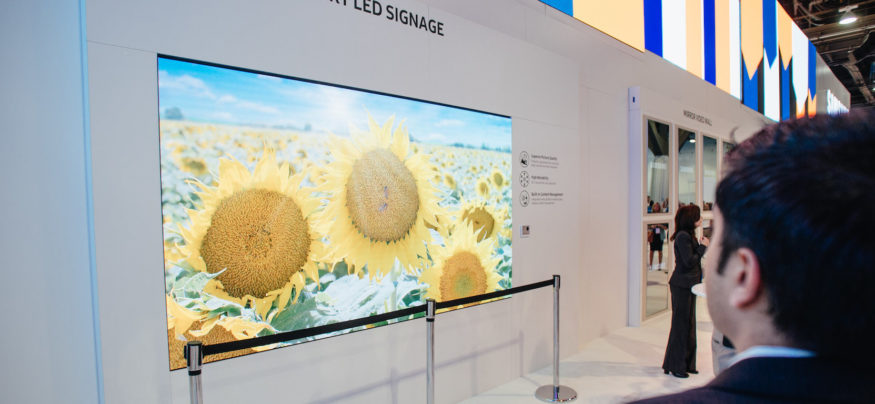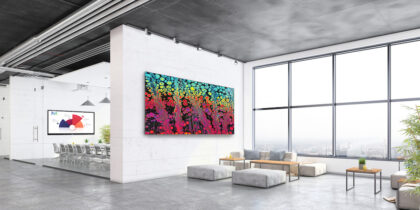The big moment for fine pixel pitch LED display technology came when AV pros at trade shows had to stop and think about the video wall they were seeing at a booth. Was that LED they were looking at, or some really narrow bezel LCD displays?
Direct-view LED displays have come a long way, quickly. Five years ago, indoor LED only got used when a viewing audience was going to be at least 40 feet away. Any closer, and the visuals were too bright and pixelated. AV pros knew, absolutely, when they were looking at LED. Fast-forward to today, and the finest pixel pitch displays rival the best-looking LCD walls.
Indoor LED is expected to gradually take over from LCD as the display technology of choice for large digital canvases because they enable seam-free visuals, offer more flexibility in the shape and scale of a video wall, and have certain technical advantages over LCDs, like color depth and reproduction.
The annual Digital Signage Expo trade show in Las Vegas from March 28-31 will see numerous display vendors showcasing the latest advances in indoor LED.
A Quick Primer
LED displays are marketed by pixel pitch — the distance between the center of the tiny LEDs of an indoor LED display module. The closer the LEDs, the better things look in close proximity.
The finest pixel pitch displays look good from 8-10 feet away. Any closer, and viewers will start to see the individual LED pixels. This technology is called direct-view LED, distinguishing it from LED-lit LCD displays.
An LCD display is illuminated by hidden LED light strips, while viewers are looking directly at the light source with indoor LEDs.
Deep, Rich And Uniform
Top manufacturers have invested in research and development to make major improvements in the visual experience of indoor LED. Samsung’s fine pixel pitch LEDs share many of the characteristics of premium ultra HD displays sold at electronics big box stores.
LED high dynamic range (HDR) displays a vast range of color — allowing viewers to see more details in both the brightest and darkest areas of a video or still image. HDR delivers the visual highlights that get missed by regular displays — like the momentary reflection off a surface. Without HDR, those details aren’t evident.
Build the optimal video wall for your business.
Download the white paper for a free guide to the challenges and use cases for video walls. Download Now
Best of breed displays also deliver things like advanced grayscale — meaning accurate color reproduction even at low color-depth levels — and multi-gamut, a particularly technical feature that ensures detailed and customized color presentation.
Beyond Pitch
Pixel pitch remains the most important number when discussing LED in the industry — and most manufacturers tie product names to the number. But systems integrators and creative professionals are also very interested in resolution — the idea of showing 2K, 4K and even 8K super-high resolution visuals on these large digital LED canvases.
When attendees walk the floor at the Digital Signage Expo (DSE), they’ll see display vendors demonstrating LED surfaces that achieve resolutions like 4K. Putting multiple LED modules together aggregates the resolution and rolls it up to get to 4K, which is 3840 x 2160 pixels. For example, Samsung’s latest 1.5mm display module has a resolution of 320 x 360 pixels. That means a wall that is 12 modules wide and stacked 6 modules high would deliver 4K. The wall itself would be roughly 18 ft. x 10 ft. By comparison, it’s possible to buy a 40-inch 4K TV.
What To Use?
Great-looking video walls are possible with LED or LCD technology. The best choice owes to a variety of factors, including:
- Seams: LCD video wall displays have hairline seams, called bezels, between the LCD units, while LED walls have no visible seams between the modules.
- Uniformity: LCD walls need to be calibrated and recalibrated to ensure the brightness and colors are the same across all units, while LED units offer greater consistency over time.
- Pixel density: LCDs offer ultra-high resolution off even a single unit, while many LED units and much bigger surfaces are needed to realize 2K and 4K.
- Budget: Costs are dropping, but the cost per square meter for an LCD video wall is significantly lower than for a fine-pitch LED of the same dimension.
- Brightness: LEDs do a better job of overpowering ambient light, though there are ultra-bright specialty LCDs available.
These benefits and advancements are just some of the characteristics that DSE attendees will be able to see at this year’s show.
A Growing Standard
Ultimately, enterprise end-users are adopting fine-pitch LED for diverse reasons. In flagship retail stores and the lobbies of office towers, they’re being used for branding and even as “techorating” — with beautiful ambient visuals setting the tone for an environment. Media companies are using them in mass transport hubs like airports and rail stations. Casinos have them up as massive multi-sport screens in their sports books. And everyone from public utilities to security forces are using big screens in command and control environments.
As adoption rates climb, it won’t be that long before big LED canvases become a standard part of the indoor visual landscape.
Digitial signage can provide a new level of customer interaction and engagement for your enterprise.








